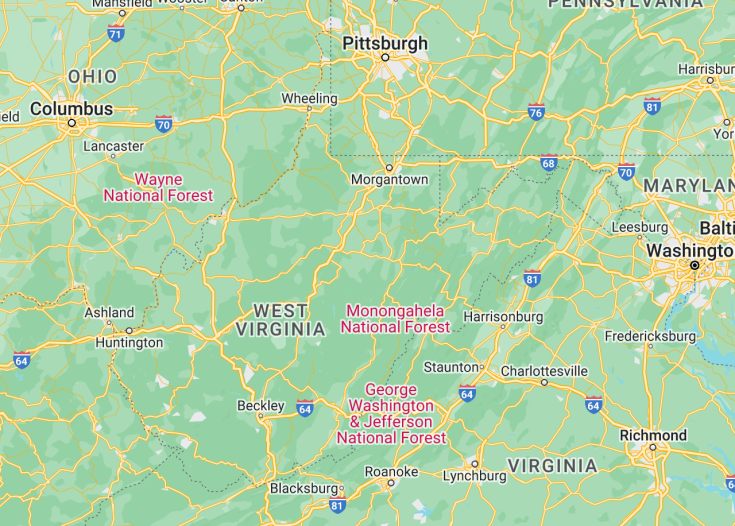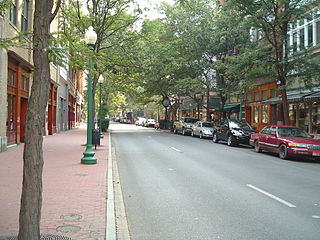West Virginia, often referred to as the “Mountain State”, boasts a rich tapestry of natural beauty, history, and Appalachian culture. Nestled within the Allegheny Mountains, this state is a haven for outdoor enthusiasts, offering rugged hiking trails, meandering rivers, and dense forests. Its towns, steeped in coal and railroad history, provide a window into a bygone era, while the sounds of bluegrass and folk music echo the spirit of its people. With each changing season, West Virginia presents a distinct, breathtaking canvas for visitors to explore and appreciate.
For an authentic experience, consider staying in local bed-and-breakfasts to engage with community hosts.
Attend one of the state’s many music festivals to truly immerse yourself in Appalachian culture.
Top destinations in West Virginia (USA)
West Virginia: the mountain state’s majestic beauty
| Capital | Charleston |
| Time in West Virginia | GMT-5 (Eastern Standard Time) |
| Language spoken | English |
| Population | Approximately 1.79 million (Source: United States Census Bureau 2022) |
| Religion | Christian (77% – predominantly Protestant) No religion/Atheist/Agnostic (18%) Other religions (5%) |
| Currency | United States Dollar ($, USD) |
| Airports | Yeager Airport (Charleston) Tri-State Airport (Huntington) North Central West Virginia Airport (Bridgeport) |
Nestled within the heart of the Appalachian Mountains, West Virginia stands as a testament to both nature’s grandeur and the indomitable spirit of the American people. From its rugged landscapes to its rich history, this state beckons travelers with stories of resilience, tradition, and natural beauty.
Historically significant, West Virginia witnessed key events during the Civil War. Harpers Ferry, in particular, carries a deep historical resonance, having been the site of John Brown’s famous raid against slavery. The state’s coal mining heritage, which played a crucial role in powering the nation’s industrial rise, is evident in its many mining towns and museums.
Yet, it’s the state’s natural allure that has consistently drawn visitors. The New River Gorge, with its stunning bridge, offers not only breathtaking vistas but also opportunities for white-water rafting, rock climbing, and hiking. The Monongahela National Forest, a vast expanse of lush woodlands, is a haven for nature enthusiasts, providing both serene spots for reflection and challenging trails for the adventurous.
West Virginia’s charm is further amplified by its cultural festivals, traditional crafts, and Appalachian music. From the state’s signature bluegrass sounds to the intricate dance of quilt-making, the rich tapestry of traditions here is palpable, making it a destination that offers both relaxation and enrichment.
Indeed, a journey through West Virginia is not just about seeing its sights, but about experiencing its soul – a blend of history, culture, and nature that’s uniquely American.
Where is West Virginia located?
West Virginia is located in the eastern United States, situated in the Appalachian region. It is bordered by Virginia to the southeast, Kentucky to the southwest, Ohio to the northwest, Pennsylvania to the north, and Maryland to the northeast.
What is West Virginia famous for?
West Virginia is renowned for its scenic beauty, especially the Appalachian Mountains, historical sites like Harpers Ferry, coal mining heritage, and outdoor recreational activities including white-water rafting in the New River Gorge and hiking in the Monongahela National Forest.
History
Pre-European Era: Ancient Cultures
Long before Europeans set foot on the land that would become West Virginia, the region was home to several Native American tribes. The Adena and Hopewell cultures, renowned for their intricate burial mounds, thrived here. Later, Eastern Woodland tribes, including the Shawnee, Cherokee, and Iroquois, made the verdant valleys and rugged mountains their home.
1600s-1700s: European Exploration
European exploration in West Virginia began in the late 1600s, with expeditions led by English and French explorers. By the mid-1700s, the British had established a more permanent presence, driven by fur trade and the lure of fertile lands. However, these incursions often led to conflicts with Native American tribes, as the two civilizations vied for dominance and control of resources.
1776-1861: Early Statehood and Expansion
The region, initially part of Virginia, played a pivotal role during the American Revolution. While distant from the primary theaters of conflict, local militias actively engaged with British loyalists. Following the Revolution, settlers moved in greater numbers into the area, leading to rapid development. However, as the 19th century progressed, tensions over issues like slavery began to create rifts between the western and eastern parts of Virginia.
1861-1865: Civil War and Statehood
The American Civil War profoundly impacted the region. Due to differing views on the institution of slavery and political representation, the western counties of Virginia opted to break away. In 1863, amidst the turmoil of war, West Virginia was officially admitted to the Union as the 35th state. The state became a crucial battleground and saw numerous engagements between Confederate and Union forces.
1865-1900: Industrialization and Coal Mining
In the post-Civil War era, West Virginia experienced an industrial boom. The state’s abundant coal reserves attracted entrepreneurs and laborers alike. Towns sprang up around mines, and railroads crisscrossed the landscape. However, the coal industry also brought challenges, including labor disputes and environmental concerns. The state became a focal point for labor rights, with events like the Battle of Blair Mountain highlighting tensions between miners and coal company operators.
20th Century: Economic Diversification
While coal remained a significant economic force, the 20th century saw West Virginia diversify its economy. Manufacturing, chemical production, and tourism began to play more substantial roles. The state’s natural beauty, showcased in areas like the New River Gorge, attracted visitors from far and wide. However, economic challenges, including the decline of coal, led to periods of hardship and the outmigration of residents seeking better opportunities.
21st Century: Modern Challenges and Renaissance
The dawn of the 21st century has seen West Virginia grapple with modern challenges, including economic diversification, infrastructure development, and addressing the opioid crisis. Yet, the state has also witnessed a cultural and economic renaissance. A burgeoning arts scene, a renewed emphasis on local and sustainable agriculture, and continued appeal as a tourist destination signify the resilience and enduring spirit of West Virginians.
Visit West Virginia
What to see and do in West Virginia
West Virginia offers a variety of attractions and activities that cater to different interests. Whether you enjoy outdoor adventures, cultural experiences, or historical sites, there is something for everyone in this diverse state. Here are some of the top attractions and things to do in West Virginia:
- Explore the natural wonders of the New River Gorge, where you can go hiking, white-water rafting, and rock climbing.
- Visit the iconic Greenbrier Resort, a historic luxury hotel that has hosted presidents and celebrities.
- Discover the rich history of Harpers Ferry, a small town that played a significant role in the American Civil War.
- Immerse yourself in Appalachian culture at the Tamarack, an arts and crafts center that showcases local talent.
- Experience the thrill of skiing or snowboarding at one of West Virginia’s ski resorts during the winter season.
Events in West Virginia
West Virginia hosts a variety of events throughout the year, showcasing the state’s vibrant culture and traditions. From music festivals to food celebrations, there is always something happening in West Virginia. Some of the annual events in West Virginia include:
- The West Virginia State Fair, held in August, features agricultural exhibits, live entertainment, and carnival rides.
- The Mountain State Forest Festival, held in October, celebrates the state’s forestry industry with parades, pageants, and traditional crafts.
- The Bridge Day Festival, held in October, attracts thrill-seekers from around the world who come to watch or participate in base jumping off the New River Gorge Bridge.
- The West Virginia Italian Heritage Festival, held in September, celebrates the state’s Italian-American community with food, music, and cultural events.
Best time to visit West Virginia
The best time to visit West Virginia depends on your preferences and what you want to experience. If you are interested in outdoor activities such as hiking, white-water rafting, and rock climbing, the spring and fall seasons are ideal. The weather is mild, and the foliage during the fall is breathtaking.
For skiing and snowboarding enthusiasts, the winter season offers plenty of opportunities to hit the slopes in West Virginia’s ski resorts. The state’s ski season typically runs from December to March.
Summer can be hot and humid in West Virginia, but it’s a great time to explore the state’s natural beauty and enjoy water activities in lakes and rivers.
Is West Virginia worth visiting?
Yes, West Virginia is worth visiting for its natural beauty, rich history, and unique cultural experiences. The state offers a diverse range of attractions and activities that cater to different interests, whether you are an outdoor enthusiast, history buff, or art lover.
West Virginia’s stunning landscapes, such as the New River Gorge and the Appalachian Mountains, provide endless opportunities for outdoor adventures. The state’s rich history, including its role in the American Civil War, offers plenty of historical sites and museums to explore.
Additionally, West Virginia’s cultural heritage, influenced by its Appalachian roots, can be seen in its music, arts, and crafts. Whether you are attending a local music festival or visiting an arts and crafts center, you will get a glimpse into the unique traditions of the region.
While every destination has its own pros and cons, West Virginia’s natural beauty and rich cultural heritage make it a worthwhile destination for tourists seeking an immersive and authentic experience.













